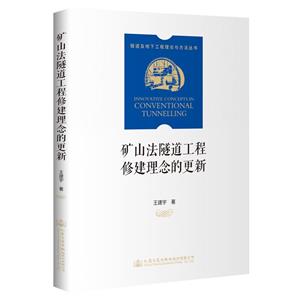第1讲 从“支撑”到“支护”——围岩的力学行为和工程应对理念 1
1.1 隧道结构设计模型 1
1.2 对“作用和反力”模型的质疑 2
1.3 围岩对隧道开挖的响应 6
1.4 “连续体”模型 18
1.5 “收敛—约束”模型 22
1.6 隧道设计手段的综合 24
第2讲 隧道修建理念更新的技术背景——围岩支护技术的进步 35
2.1 纤维喷射混凝土 36
2.2 岩土锚固技术 45
2.3 超前支护技术 62
第3讲 对形变压力的认识——围岩挤压型变形问题探讨 73
3.1 各类不同性质的“大变形” 73
3.2 高地应力软弱围岩的特异性 77
3.3 挤压性围岩处治理念——围岩变形的适度释放 86
3.4 可让型支护系统 88
3.5 挤压性围岩隧道工程中的岩体锚固技术 93
3.6 可让型支护案例 95
3.7 预留变形量问题 96
3.8 二次衬砌的施作时机 101
3.9 挤压型变形处治的基本理念和要点 104
第4讲 “以排为主”还是“以堵为主”——隧道工程地下水处治 107
4.1 地下水处治的主要手段、治水理念的技术背景 108
4.2 从“以排为主”到“以堵为主” 110
4.3 静水压力分布规律和全封闭方案 112
4.4 地下水排导方案 117
4.5 排导方案衬砌水压力荷载 121
4.6 水压力荷载问题的解析 124
4.7 地下水排放流量的控制 130
4.8 “限量排放”理念的内涵 134
4.9 渗流计算的数值方法 137
4.10 “双重型衬砌”的水力特性 143
4.11 关于初始水头问题 156
4.12 隧道工程地下水处治的基本理念和要点 158
第5讲 与时俱进的多样性——隧道衬砌结构形式的拓展 161
5.1 隧道衬砌结构的演变 161
5.2 挂板防水和“双重型衬砌”(DSL) 164
5.3 喷膜防水和“复合型衬砌”(CSL) 170
5.4 “单一型衬砌”(SSL) 177
5.5 衬砌结构形式的多样化 183
附录 术语的更新 187
参考文献 189
Chapter 1 From passively supporting to actively controlling
——Mechanical behavior of the surrounding rock and response concepts in tunnelling 1
1.1 Structural design models for tunnelling 1
1.2 Calling in question on “action and reaction models” 2
1.3 Response of the surrounding rock to the excavation 6
1.4 Continuum models 18
1.5 Convergence-confinement models 22
1.6 Comprehensive use of various design methods for tunnelling 24
Chapter 2 The technological background of innovative concepts in tunnelling
——Development of rock supporting techniques 35
2.1 Fiber reinforced sprayed concrete 36
2.2 Rock anchoring techniques and rock bolts 45
2.3 The advance support system 62
Chapter 3 Facing the genuine pressure
——Discussion on problems of tunnelling under squeezing ground conditions 73
3.1 Different types of so called “large deformation” 73
3.2 Specificity of the weak surrounding rock under the high in-situ pressure 77
3.3 The key way is to release deformations suitably for tunnelling
under squeezing ground conditions86
3.4 The yielding support system 88
3.5 Rock bolting for tunnelling under squeezing ground conditions 93
3.6 A project case of the yielding support system 95
3.7 The deformation allowance value for tunnelling
under squeezing ground conditions 96
3.8 The opportune moment for secondary lining construction 101
From passively supporting to actively controlling
——Mechanical behavior of the surrounding rock and response concepts in tunnelling 1
1.1 Structural design models for tunnelling 1
1.2 Calling in question on “action and reaction models” 2
1.3 Response of the surrounding rock to the excavation 6
1.4 Continuum models 18
1.5 Convergence-confinement models 22
1.6 Comprehensive use of various design methods for tunnelling 24
The technological background of innovative concepts in tunnelling
——Development of rock supporting techniques 35
2.1 Fiber reinforced sprayed concrete 36
2.2 Rock anchoring techniques and rock bolts 45
2.3 The advance support system 62
Facing the genuine pressure
——Discussion on problems of tunnelling under squeezing ground conditions 73
3.1 Different types of so called “large deformation” 73
3.2 Specificity of the weak surrounding rock under the high in-situ pressure 77
3.3 The key way is to release deformations suitably for tunnelling
under squeezing ground conditions86
3.4 The yielding support system 88
3.5 Rock bolting for tunnelling under squeezing ground conditions 93
3.6 A project case of the yielding support system 95
3.7 The deformation allowance value for tunnelling
under squeezing ground conditions 96
3.8 The opportune moment for secondary lining construction 101
3.9 Key points for tunnelling under squeezing ground conditions 104
Chapter 4 “Draining first” or “sealing first”
——Tunnel Waterproofing 107
4.1 The technical background of tunnel waterproofing concepts 108
4.2 Compare draining with sealing 110
4.3 Distribution of the static pressure caused by ground water and
discussion on the full sealing approach 112
4.4 Ground water draining approach 117
4.5 The water pressure loaded on the lining in case of application of the draining
approach 121
4.6 Analytic solution of the load caused by ground water 124
4.7 Control of the flow rate 130
4.8 Concept about the limited flow rate 134
4.9 Numerical methods for seepage calculation 137
4.10 The double shell lining under the load caused by ground water 143
4.11 Determination of the In-situ water head 156
4.12 Basic concepts and key points for tunnel waterproofing 158
Chapter 5 Multiformity of tunnel linings
——Expansion forms of tunnel lining systems 161
5.1 Development of tunnel lining forms 161
5.2 Sheet membranes and the double shell lining (DSL) 164
5.3 Spray applied membranes and the composite shell lining (CSL) 170
5.4 The single shell lining (SSL) 177
5.5 Various forms of tunnel lining systems 183
Appendix Updating of terms 187
References 189















